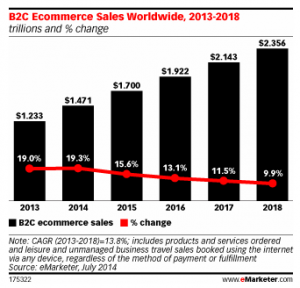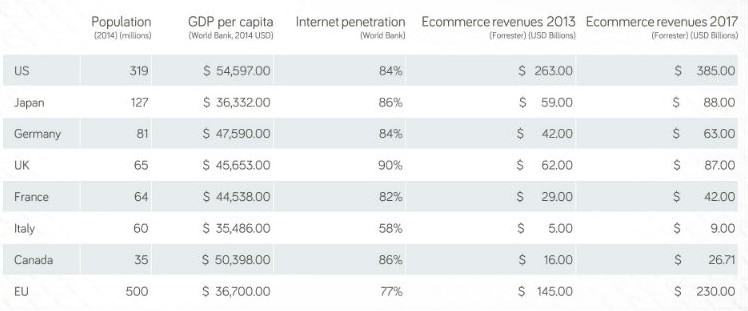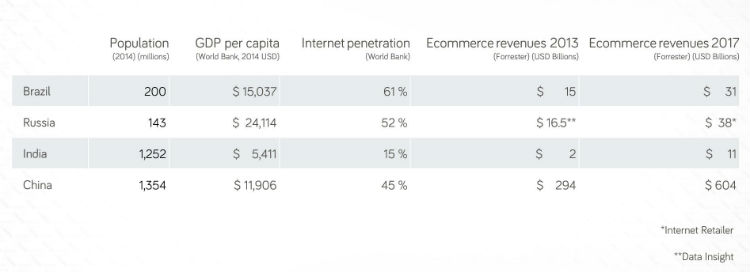Is there a real opportunity for online sales in markets like Brazil, Russia, India and China – or is everything you’ve been hearing about BRIC ecommerce just hype?
Jim, We Need More Revenue
As an ecommerce professional, I’m sure you are familiar with this scenario: Your boss calls you in and tells you to to generate more revenue. So you:
- Optimize conversions on your shopping carts with split tests
- Plan email marketing campaigns
- Invest in search engine marketing and pay-per-click advertising
- Improve your social media presence
Of course, all these activities are targeting customers in your primary market, which is likely to be wherever your company is located. After all, you intuitively understand these customers’ shopping preferences.
Sometime in the future, you get called in and your boss says again, “Let’s raise more revenue.”
Well, you’ve got a pretty well-oiled machine when it comes to your primary market, but logically, the more customers you win, the slower your growth is going to be. At this point it’s time to consider your global ecommerce opportunity.
According to Forrester Research, “International expansion is top of mind for many eBusiness executives: In a recent survey of US-based online retailers, 75 percent of respondents ranked international expansion as either “very important” or “somewhat important” to their overall business strategies.”
Global Ecommerce Market

The global ecommerce market is full of opportunity. According to eMarketer, global ecommerce B2C sales will reach $1.7 trillion by the end of 2015, and will continue to express double digit growth rates through 2018. This means the amount of money spent online for all retail goods eclipses the value of most countries’ GDPs.
You can’t expand to every market all at once. You need to prioritize. So, which market should you target first?
G7 Ecommerce
The obvious answer is to start with the G7 countries. This group of seven developed countries represent the most advanced economies (and mature ecommerce markets) in the world.
Finance ministers and heads of banks from these countries get together every year and figure out the best way to do business with each other. They discuss interest rates, taxes and currency exchanges. They talk about infrastructure, shipping routes and Internet access. Together, these politicians and bankers invest in each others’ peoples and businesses to create more wealth for themselves and the people they represent.
Note the high GDP per capita of these countries, their Internet penetration and ecommerce revenues:
This data tells us how many people have how much money to spend online. Seeing as these countries are so strong in GDP per capita (which we use to inform pricing strategies, as it helps us accurately gauge what a consumer in a given country is likely able to afford), Internet penetration (which tells us how many people are online), and ecommerce revenue growths, it is logical that these countries should be the first place you target as part of your ecommerce expansion strategy.
BRIC Ecommerce
In 2001, Jim O’neill, the head of global economic research for Goldman Sachs, published a paper called “Building Better Global Economic BRICs.” In it, he identifies Brazil, Russia, India and China as four countries that will rival the economic power of the G7 in the coming years. But at their current stage of development, they leave a lot to be desired in terms of ecommerce opportunities:
Despite their massive populations, these countries are not yet fully online. Nor do they have tons of cash to spend, yet. And aside from China, which is an ecommerce behemoth, the online retail revenues are not nearly as compelling as those of the G7.
Still, they are poised for massive growth. With emerging middle-classes in each of these growth markets, ecommerce merchants must take note and begin their plan for entering these markets. If you dedicate your efforts today, you will be more prepared than your competitors to reap the rewards when these countries fully develop into strong ecommerce markets.
Keystone
When it comes to your global ecommerce expansion, you want to begin with the mature markets of the G7. However, rather than taking a wait-and-see approach with the BRIC markets, your best bet is to start sowing the seeds of ecommerce growth now. Otherwise, your competitors will. Its only a matter of time before the massive populations in those countries truly develop into ecommerce powerhouses. Spend your time now learning the right way to convert customers there.
Part 2 will examine how to localize for the Brazilian ecommerce market.

